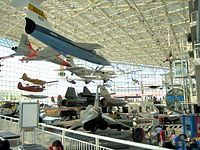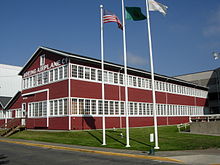- Museum of Flight
-
Coordinates: 47°31′08″N 122°18′00″W / 47.519°N 122.3°W
Museum of Flight 
The museum's Great Gallery.Established 1965 Location King County International Airport (Boeing Field)
9404 E. Marginal Way
Seattle, Washington, U.S.Type Aviation museum Visitor figures 400,000+ per year President Douglas R. King[1] Curator Dan Hagedorn[2] Website museumofflight.org The Museum of Flight is a private non-profit air and space museum at King County International Airport (Boeing Field), south of downtown Seattle, Washington.[3] It was established in 1965 and is fully accredited by the American Association of Museums. As the largest private air and space museum in the world, it also hosts the largest K-12 educational programs in the world.
The museum attracts over 400,000 visitors every year. The museum serves more than 140,000 students yearly through both its onsite programs: a Challenger Learning Center, an Aviation Learning Center, and a summer camp (ACE), as well as outreach programs that travel throughout Washington and Oregon.[4]
Contents
History
The Museum of Flight can trace its roots back to the Pacific Northwest Aviation Historical Foundation, which was founded in 1965 to recover and restore a 1929 Boeing 80A-1, which had been discovered in a landfill in Anchorage, Alaska. The restoration took place over a 16 year period, and after completion, was put on display as a centerpiece for the museum. In 1968, the name "Museum of Flight" first appeared in use in a 10,000-square-foot facility, rented at the Seattle Center. Planning began at this time for a more permanent structure, and preliminary concepts were drafted.[5]
In 1975, The William E. Boeing Red Barn was acquired for one dollar from the Port of Seattle, which had taken possession of it after Boeing abandoned it during World War II. The 1909 all-wooden Red Barn, the original home of the company, was barged two miles (3 km) up the Duwamish River to its current location at the southwestern end of Boeing Field. After restoration, the two-story Red Barn was opened to the public in 1983.
That year a funding campaign was launched, so capital could be raised for construction of the T.A. Wilson Great Gallery. In 1987, then-Vice President George H. W. Bush cut the ribbon to open the facility, with an expansive volume of 3,000,000 cubic feet (85,000 m3). The gallery's structure is built in a space frame lattice structure and holds more than 20 hanging aircraft, including a Douglas DC-3 weighing more than nine tons.[5]
The museum's education programs grew significantly with the building of a Challenger Learning Center in 1992. This interactive exhibit allows student's to experience a Space Shuttle mission. It includes a mock-up NASA mission control, and experiments from all areas of space research.
Completed in 1994, the 132-seat Wings Cafe and the 250-seat Skyline multipurpose banquet and meeting room increased the museum's footprint to 185,000 square feet (17,200 m2). At the same time, one of the museum's most widely recognized and popular artifacts, the Lockheed M-21, a modified Lockheed A-12 Oxcart designed to carry the Lockheed D-21 reconnaissance drones, was placed on the floor at the center of the Great Gallery, after being fully restored.[6]
The first jet-powered Air Force One (1959-62, SAM 970), a Boeing VC-137B, was flown to Boeing Field in 1996. Retired from active service earlier that year, it is on loan from the Air Force Museum. Originally parked on the east side of the museum, it was driven across East Marginal Way and now resides in the museum's Airpark, where it is open to public walkthroughs.
In 1997, the museum opened the first full scale, interactive Air Traffic Control tower exhibit. The tower overlooks the Boeing Field runways, home to one of the thirty busiest airports in the country. The exhibit offers a glimpse into what it is like to be an air traffic controller.
The next major expansion was opened in 2004, with the addition of the J. Elroy McCaw Personal Courage Wing. North of the Red Barn, the wing has 88,000 square feet (8,200 m2) of exhibit space on two floors, with more than 25 World War I and World War II aircraft. It also has large collection of model aircraft, including every plane from both wars.[7]
In June 2010, the museum broke ground on a $12 million new building to house a Space Shuttle it hoped to receive from NASA.[8] The new building will include multisensory exhibits that emphasize stories from the visionaries, designers, pilots, and crews of the Space Shuttle.[9] Though the museum did not receive one of the three remaining shuttles, it did receive a shuttle mockup that was used to train astronauts. Because it is a trainer and not an actual shuttle, the public will be allowed to enter its interior.[10] The new gallery is slated to open in April 2012.
Aircraft on display
The Museum of Flight has more than 80 aircraft, including:
- the first flight-worthy Boeing 747 airliner, the City of Everett. Its registration number is N7470, and it was named after the city of Everett, Washington. Its first flight was on February 9, 1969.
- the first presidential jet, VC-137B SAM 970, which served in the presidential fleet from 1959 to 1996 (open for walkthrough)
- British Airways Concorde number 214, registration G-BOAG, the only Concorde west of the Appalachians (open for walkthrough).
- a Caproni Ca.20, the world's first fighter plane from World War I. The one on display at the Museum of Flight was the only one ever built.
- Lockheed D-21 unmanned reconnaissance drone, atop the only surviving M-21[11] a variant of the Lockheed A-12.
- the prototype Boeing 737.
- the second Lockheed Martin/Boeing DarkStar Tier III unmanned vehicle prototype
- the Gossamer Albatross II human-powered aircraft.
- one of five Aerocars, automobiles with detachable wings and propeller
- LearAvia Lear Fan prototype N626BL
- one of only two remaining airworthy Douglas DC-2s.
- the only surviving Boeing 80A, flown by Bob Reeve in Alaska.
- An American Airlines Boeing 727.
- An ex-Trans-Canada Air Lines Lockheed L-1049G Super Constellation located originally at the Toronto Pearson International Airport which was purchased in a controversial transaction in 2005. It is currently on display at the airpark.[12]
- The Lamson L-106 Alcor, the world's first pressurized sailplane.[13][14][15]
Exhibits and Facilities
On its grounds is the Personal Courage Wing (PCW) with 28 World War I and World War II aircraft from several countries including Germany, Russia, and Japan.
There is also the "Red Barn", a registered historic site also known as Building No. 105. Built in 1909, the building was used during the early 1900s as Boeing's original manufacturing plant. Through photographs, film, oral histories, and restoration of work stations the exhibits in the Red Barn illustrate how wooden aircraft structure with fabric overlays were manufactured in the early years of aviation and provides a history of aviation development through 1958.
In June of 2007 the Museum opened a new space exhibit: "Space: Exploring the New Frontier", which traces the evolution of space flight from the times of Dr. Robert Goddard to the present and into future commercial spaceflight.
Restoration facility
The museum maintains a restoration facility at Paine Field in Everett with about 39 ongoing projects including a de Havilland Comet 4 jet airliner, a Jetstar, a FM-2 Wildcat, among many. A previous project, the only flyable Boeing 247 in existence, is based from the airfield at the restoration center. A restored B-17, currently the only flyable B-17F variant of the B-17[16] and a B-29 in progress are currently hangared at Boeing Field. The B-17 is displayed seasonally in the summer, on the grass next to the B-47, in front of the Museum's entrance.
Museum of Flight Library
The museum has a library dedicated to aviation that is open to the public.
It was founded in 1985. As of 2011 it contains 66,000 books and subscribes to 100 periodicals. It specializes in aerospace and aviation. Its special collection includes the G S Williams photographic collection, the peter bowers photo collection, the DD Hatfield Aviation History collection, the E B Jeppesen Aviation History and Navigation collection, the Fighter Aces Association Archives, the Lear Archives, and the Wright Airplane Company Collection.[17]
The library contains the Dalhberg military aviation collection.[citation needed] The library also accepts research requests from the general public.
Other facilities
On August 23, 2011, the Museum of Flight, along with the Highline Public Schools broke ground on the new home of Aviation High School. The building will be owned and operated by the museum, and is located directly north of the Museum's Airpark. The new school will be completed in 2013.[4] The facility will also be used for the museum's summer education programs when school is not in session.
There are also plans to enclose the Airpark with a roof, covering the currently exposed aircraft from the weather. The roof will span the gap between the future Aviation High, and the newly built Space Gallery. The cover will also allow aircraft which are seasonally brought out, such as the Museum's B-17, to be permanently on display.
See also
- List of aerospace museums
References
- Notes
- ^ "Museum of Flight names new president and CEO." Museum of Flight, November 4, 2010
- ^ "Dan Hagedorn." Museum of Flight. Retrieved: September 2, 2011.
- ^ "Museum of Flight." travel.yahoo.com. Retrieved: September 2, 2011.
- ^ a b "Museum of Flight/Aviation High Press Release" museumofflight.org Retrieved: September 8, 2011.
- ^ a b Ogden, 1986 p. 193.
- ^ Ogden, 1986 p. 194.
- ^ "General History Fact Sheet." The Museum of Flight, 2004. Retrieved: August 9, 2011.
- ^ "Photo Gallery: How to display a retired space shuttle." Collect Space. Retrieved: February 4, 2011.
- ^ "Space Gallery Construction Has Begun." The Museum of Flight, 2010. Retrieved: March 30, 2011.
- ^ "Museum of Flight Awarded Full-Fuselage Shuttle Trainer." The Museum of Flight. Retrieved: 13 April 2011.
- ^ "Lockheed M-21 Blackbird." The Museum of Flight. Retrieved: September 2, 2011.
- ^ "Super Constellation CF-TGE." rbogash.com. Retrieved: November 26, 2010.
- ^ "Alcor Lamson." Activate Media, 2006. Retrieved: 20 May 2011.
- ^ Said, Bob: 1983 Sailplane Directory, Soaring Magazine, page 46. Soaring Society of America November 1983. USPS 499-920
- ^ "Lamson L-106 Alcor Glider." Museum of Flight, May 2011. Retrieved: 20 May 2011.
- ^ Baugher, Joe. "1942 USAAF Serial Numbers (42-001 to 42-30031)." American Military Aircraft. Retrieved: September 2, 2011.
- ^ American Library Directory. 2 (64th ed.). Information Today, Inc. 2011-2012. pp. 2568-2576. ISBN 978-1-57387-411-3.
- Bibliography
- Ogden, Bob. Great Aircraft Collections of the World. New York: Gallery Books, 1986. ISBN 0-8317-4066-3.
External links
- Museum of Flight official website
- Aviation: From Sand Dunes to Sonic Booms, a National Park Service Discover Our Shared Heritage Travel Itinerary
Lists relating to aviation General Aircraft (manufacturers) · Aircraft engines (manufacturers) · Airlines (defunct) · Airports · Civil authorities · Museums · Registration prefixes · Rotorcraft (manufacturers) · TimelineMilitary Accidents/incidents Records Categories:- Aerospace museums
- Aerospace museums in Washington (state)
- Museums established in 1965
- Institutions accredited by the American Association of Museums
- Boeing
- Science museums in Washington (state)
- Museums in King County, Washington
- Industry museums in Washington (state)
- Space Shuttle tourist attractions
- Libraries in Seattle
Wikimedia Foundation. 2010.



